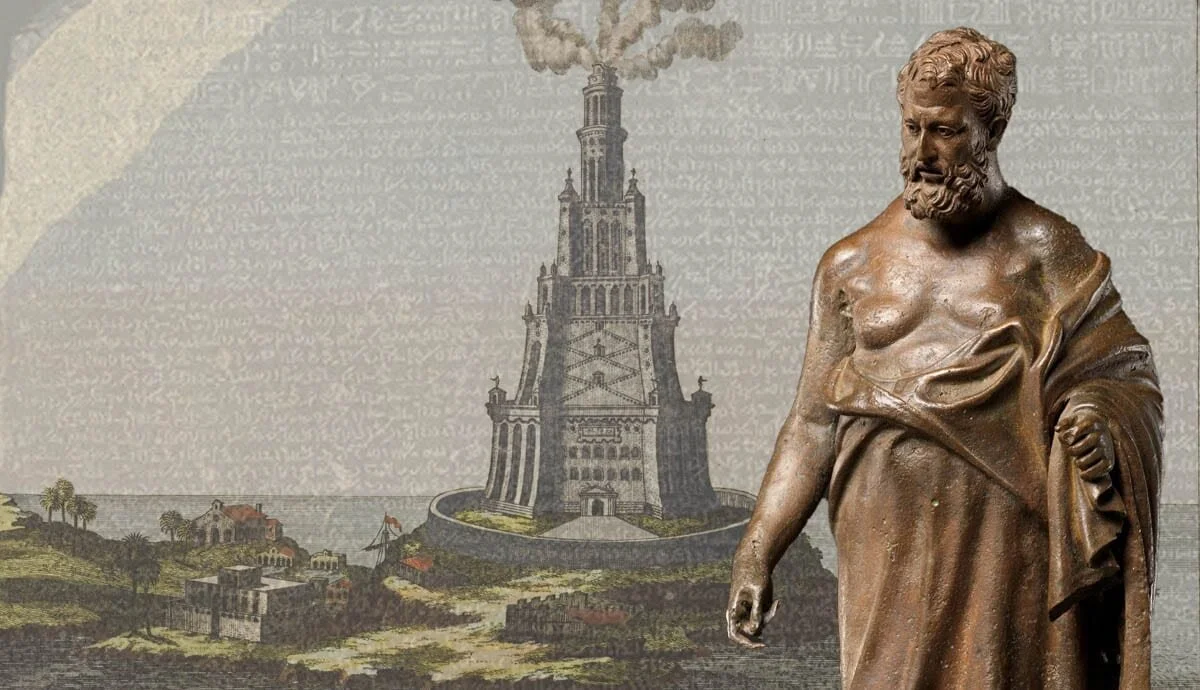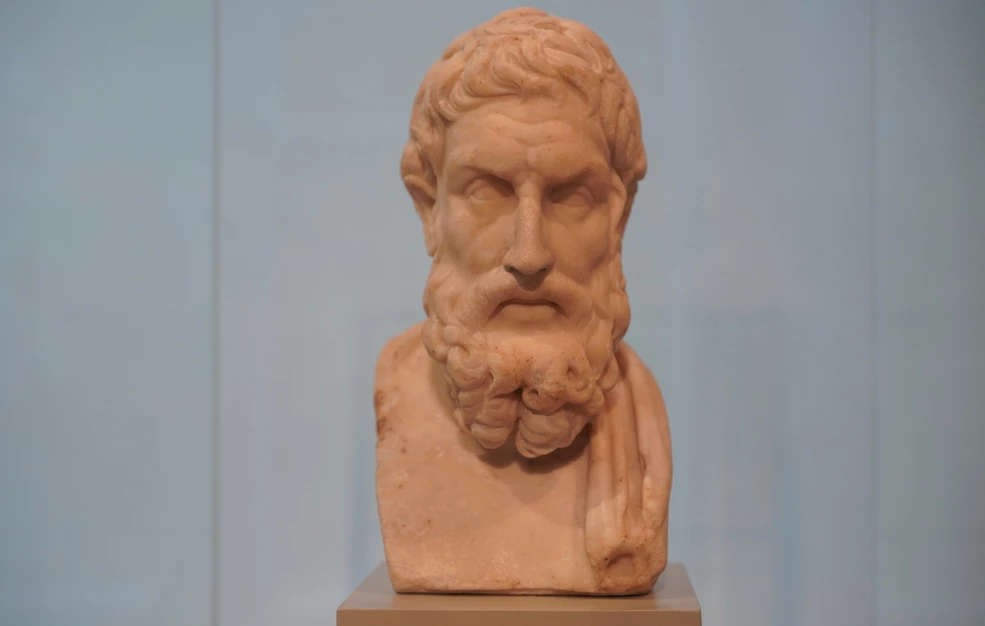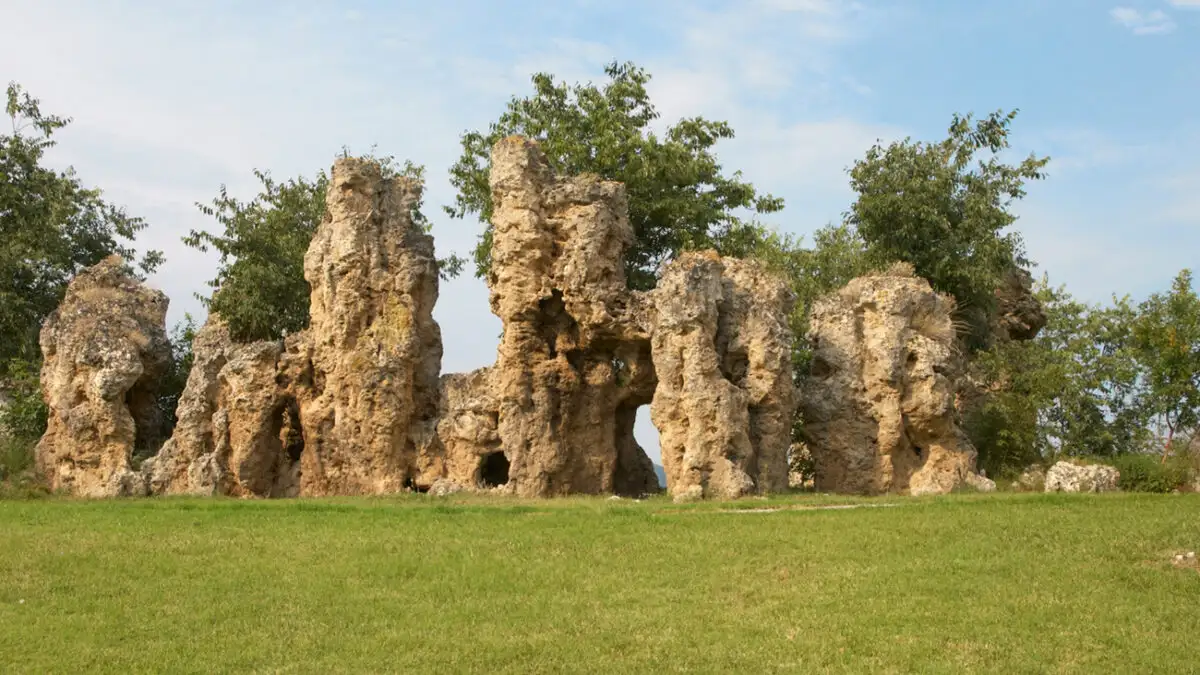The city of ancient Alexandria was an intellectual juggernaut. Greek, Egyptian, and Roman learning were drawn together here in a unique project to catalog and refine all the world’s knowledge.
by Alice Bennett
Engraving of the Lighthouse of Alexandria; with A Roman Statue of a Philosopher, late 1st century BC
The foundation of the city of ancient Alexandria was one of Alexander the Great’s most enduring legacies. A strategic masterstroke, he placed the city between Lake Mareotis and the Aegean Sea, producing an enormous natural harbor for trade and defense.
Upon his death, Greek Egypt became a wealthy and powerful international player, overseen by his successor Ptolemy I. While the star of Athens was in eclipse, the ancient city of Alexandria rose to become the intellectual capital of the ancient world, unrivaled until the middle ages.
Here are ten reasons ancient Alexandria was the leviathan of learning.
1. Ancient Alexandria’s Debt To Aristotle
Etching of Aristotle by Raphael, via the Wellcome Collection, London
From its inception, Alexandria was imbued with the spirit of curiosity.
The first Ptolemy who ruled ancient Alexandria in the 3rd century BC was most likely tutored by the great Aristotle. Aristotle’s lifelong mission had been to amass all human knowledge and teach it to future generations. He founded the Lyceum in Athens, which was a true university in the modern sense.
At the Lyceum he built a great private library as well as a museum of objects, many of which had been sent back to him by Alexander the Great. But Athens was a declining power and it would be Alexander’s successors who drew to them the great minds of their day. Ptolemy would embark on an Aristotelian project of his own, collecting objects and books.
This intellectual ideal, whether it passed directly or not from Aristotle, became the ethos of the Ptolemaic dynasty and Ptolemy II was taught by one of Aristotle’s successors, the philosopher Strato of Lampsacus.
The huge importance of Aristotle as a founding influence cannot be overstressed. His philosophy had been based on observation and data collection as well as logical reasoning — in other words, an early attempt to develop the scientific method.
Alexandria’s culture of learning was a long way from the hopelessly abstract philosophical musing of other intellectual centers in the ancient world. A culture of rigorous empirical study arose on a large scale for the first time.
2. The Great Library Of Alexandria
Ptolemaic Papyrus, 265-64 BC, via the British Museum, London
Ptolemy’s project began with an attempt to create a great library. He summoned Demetrius of Phaleron, an Athenian politician and pupil of Aristotle, and began a project like no other. Unlike Aristotle, Ptolemy had the budget of a wealthy nation behind him. Demetrius was given a large amount of money and ordered to find every book in the world.
All of Ptolemy’s successors would follow his example, sending scholars to every known corner of the earth to copy texts at the state’s expense. In addition to the great works of Greek antiquity, books from far-flung places made their way to Alexandria. Among its more exotic contents, treatises on Zoroastrianism compiled in Iran were shipped to the library.
Every ship that entered the massive Alexandrian harbor had to turn over their books by law. The books were then copied, and a copy was handed back to its owner. The debate over how many books were in the collection still rages, but half a million is the typical estimate.
3. Trade And Diversity In The Ancient City
The Rosetta Stone, 196 BC, via the British Museum, London
Part of the success of the library project came from the melting pot that made up ancient Alexandria. Three distinct but highly literate cultures composed the majority of the population from its founding.
They were, a) the Greek-speaking peoples brought by Ptolemy, b) the indigenous Egyptian population, and c) a huge Jewish diaspora, who moved to Alexandria after the conquest of Jerusalem.
These three cultures at this point in history were unsurpassed for their wealth of learning and history of careful recording. The library’s main collection was mostly Greek, with a huge number of Egyptian texts, and Greek translations of Hebrew writings. A text very similar to the famous Rosetta Stone comes from ancient Alexandria, the work of translators working in multiple languages.
Alexandria continued to be a vibrant multicultural center into the Roman period. Its enormous harbor became an important trading center. Egypt was the breadbasket of the world from the Ptolemaic period until the fall of Rome. All who wished to trade with her would filter in through the great harbor. The ancient city became phenomenally wealthy and cosmopolitan.
In addition to grain, Alexandria exported books, not only because it was a center for scholarship, but because Egypt controlled the paper trade, made from papyrus. This alone drew more people from more corners of the earth, looking for lost knowledge.
4. The Musaeum
Silver Coin depicting Ptolemy I, via the British Museum, London
Manuscripts were not the only thing the Ptolemies wanted; they wanted to keep great scholars in their midst as well. The library itself was part of a much bigger complex, known as the Musaeum or Mouseion, “the shrine of the Muses.” Although it is from the musaeum we get the modern word museum, it was more than an interesting collection of artifacts.
Comprising of a communal dining hall and study area with colonnaded walkways, scholars stayed here to pursue a range of interests from mathematics to astronomy, geography and literature. Talented thinkers were paid by the Ptolemaic state, and later by Roman Emperors, to stay at the musaeum. Within reason, free-thought and intellectual inquiry were encouraged, with the help of first-rate facilities.
What exactly was in the musaeum’s collection is unknown, although we do know the Ptolemies maintained an excellent zoo. It probably also had exotic artifacts from around the world, just like Aristotle’s collection.
The number of great ancient thinkers we know of who worked in Alexandria is extensive. It is no exaggeration to say that Ptolemy’s wealth had created the greatest intellectual center on earth.
5. Medicine Unleashed
Greek Medical Equipment, via the British Museum, London
Ancient medicine achieved its peak under the Ptolemaic kings of Egypt. Greek doctors in the classical period had gone some way to studying anatomy, but they had spent more time coming up with extensive theoretical models for the workings of the human body.
The Egyptians on the other hand had a far better grasp of practical anatomy due to a long history of mummification.
Ancient religion was a significant barrier in the way of medical progress in the ancient world. To truly understand the body dissection was needed, or even better — vivisection — dissection with a live subject. Religious prohibitions across the Greek and Roman world made this impossible for most of antiquity, but the Ptolemies were more interested in medical knowledge than in religious purity and they took the breaks off. Prisoners were given over to budding scientists for vivisection.
Although cruel, the Alexandrians made huge strides in medical knowledge due to this practice. The famous medical duo Herophilus and Erasistratus in particular wrote important texts passed down for generations. Between them, they were able to describe the motor and sensory nervous system, most of the organs, the brain, and the optic nerve for the first time. They also contributed enormously to the understanding of the heart and blood circulation. Herophilus’ work on the heart would not be matched again until William Harvey in the 19th century.
6. Mathematical Masterminds And Engineering Triumphs
Engraving of the Lighthouse of Alexandria, via the Wellcome Collection, London
The emphasis on the practical use of mathematics was not always obvious to pre-modern people even in the erudite ancient world. Not so in Alexandria. The competitive spirit of the Hellenistic Greek states led to a series of wonders and architectural marvels, fuelled by the leaps and bounds made in mathematics and engineering.
The most famous of ancient Alexandria’s cadre of mathematicians was the brilliant Euclid. His ground-breaking textbook on mathematics, the Elements, is still used to this day.
The greatest engineer of all was Archimedes, of screw fame. In addition to being an early developer of calculus, Archimedes was heavily involved in the complex political situation of his day and was regularly wheeled out to solve various technological problems for his royal masters in Syracuse. In addition to finding a way to move water uphill, and creating early cranes from a system of pulleys, he appears to have used his knowledge of mathematics to create an early form of clockwork.
By far the most impressive project fuelled by Alexandrian mathematical knowledge was the Great Lighthouse, one of the seven wonders of the world. The lighthouse was built by the famous architect Sostratus of Cnidus, aided by Alexandria’s army of mathematicians. Built on the island of Pharos to protect boats from Alexandria’s reefs, it is believed to have stood at 400 feet high, with a huge brass disc at its head, which reflected light out to sea.
7. Music And Machines In Ancient Alexandria
A Replica of Hero’s Ancient steam engine, via the Science Museum Group, London
The other great spark which fostered the development of physics, in particular, was the use of mechanical devices to fuel creative projects such as festivities and plays. Machinery was used to create illusions at festivals in the deeply religious ancient city. The Ptolemies were particularly fond of automatons, and this trend seems to have continued into the Roman period.
Hero of Alexandria is less well known than his predecessor Archimedes but is credited with some astonishing achievements. His chief interest was in hydraulics, and he made machines that used water to power moving parts. Like Leonardo da Vinci after him, a lot of his work was actually used to create theatrical displays to entertain wealthy grandees in ancient Alexandria.
He made automatic doors for temples, singing fountains using pressurized air and water, and a wind-powered pipe organ. He was fascinated by physics and movement, and his greatest invention was an early form of a steam engine, the significance of which appears to have passed the ancients by.
8. Mapping The Stars At The Observatory
A 16th-century Armillary sphere of the Ptolemaic model, via the Science Museum Group, London
The great musaeum had its own dedicated astronomical observatory. Its most famous occupant was the brilliant astronomer Ptolemy, who worked in the musaeum during the Roman period (2nd century AD). Ptolemy’s achievements were considerable, he cataloged the stars and made some brilliant mathematical discoveries. He was so respected that his model of the solar system would be used until Copernicus replaced it in the 16th century.
Astonishingly, a lesser-known stargazer who worked at Alexandria actually anticipated Copernicus. Aristarchus from Samos promoted a heliocentric model of the solar system far in advance of everyone else, correctly deducing the universe must be far larger than it appeared to ancient eyes.
The achievements of the astronomers of Alexandria were made using the advances in equipment developed at the observatory over hundreds of years. There were no telescopes in the ancient world, but a succession of astrolabes, dioptra, and armillary spheres (globe-shaped models of the heavens) were developed to produce increasingly accurate observational models of the stars.
9. Twilight Of The Philosophers
A Roman Statue of a Philosopher, late 1st century BC, via The Metropolitan Museum of Art, New York
Towards the end of antiquity, Alexandria had its last burst of brilliance. Under the Romans, Alexandria, in competition with Athens, took the lead as the last great center for philosophical learning.
During the 4th century AD, the global mood was becoming more religious, and Alexandrian learning started to reflect this. In the Late Roman period, Plato and Pythagoras were back in fashion, and many came to Alexandria to study in these philosophical traditions. The Neoplatonists and Neopythagoreans as they are now known had mystical leanings and a quasi-religious mathematical understanding of the universe. The new trend for more religious philosophy was hugely popular in Alexandria, influenced by centuries of Egyptian religion.
The heads of the Neoplatonic school at Alexandria were believed to be part of a “golden thread” of sage-like superhuman wisemen, who passed the baton of philosophical learning to their disciples. The light of Greek philosophy would continue in Alexandria all the way up to the 7th century.
10. Rise Of The Theologians
Saint Anthony the Abbot in the Wilderness by the Osservanza Master, 1435, via The Metropolitan Museum of Art, New York
The mix of cultures and spirit of the lively debate that characterized the ancient city took a darker turn in later Antiquity, with the rise of the Catholic Church. Egypt was as fertile as it was problematic for the new faith.
Religions here had deeps roots, some of them provided an interesting jumping-off point for early Christian thinkers, as they inherited the meditative practices and ascetic leanings of Egyptian religion. The Egyptian desert would give birth to some of history’s greatest monastic figures, such as St Antony and St Pachomius.
Early Egyptian saints’ lives, depict pagan philosophers arguing in the streets with Christian monks. Typically, the saints demonstrate to the crowd that philosophy is nothing but rhetoric and sophistry. This dangerous anti-intellectual climate was a troubling development that brought massive conflict to the ancient city of Alexandria in particular. The climax of which was the murder of Hypatia, the great female philosopher and mathematician.
Outside of the militants, the gentler side of Christianity benefited enormously from Alexandrian learning. Some of Christianity’s greatest thinkers were born out of the Alexandrian milieu. Great writers such as Origen and St Clement became respected Church fathers. The late Alexandrian fervor for Plato developed in tandem with Christian philosophy, influencing it a great deal.
The Afterlife Of Ancient Alexandria
Roman Amphitheater archaeological remains in Alexandria, 4th century AD, via Ancient History Encyclopedia
In 641, Alexandria fell to Arab invaders. Its core population was so devoted to their own version of Christianity, the Coptic Christians remained under Muslim rule, and are still an important group in Egypt today. The center of global learning shifted dramatically with the rise of the Islamic empires, and the city of light is this period, was the beautiful city of Damascus, and later the city of Baghdad.
The great city of ancient Alexandria would eventually be swallowed by the ocean. The great library was burnt at an unknown date that is still heavily debated by scholars. The lighthouse and Alexandria’s other wonders were destroyed by war and decay or buried under sand. Yet Alexandria’s influence would live on; the texts produced there would drive the Renaissance and the Islamic golden age.
Source: The Collector




















